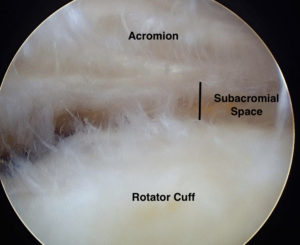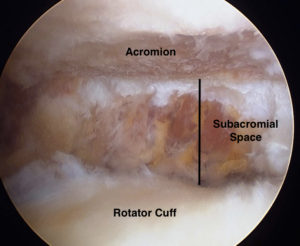 Fortunately, the need for impingement syndrome surgery is rare. I estimate that only about 1 in10 people ultimately requires surgery. However, when nonoperative treatment fails, there really are only two choices: live with the symptoms or have impingement syndrome surgery. What defines failure of nonoperative treatment is really up to you and your doc. There is no harm tolerating the symptoms for as long as you like. Prolonged impingement syndrome does not appear to lead to any other issues. Furthermore, if surgery is ultimately performed, waiting does not seem to impact the outcome. So you and your doctor can continue with nonsurgical treatment as long as you wish. However, if nonoperative treatment doesn’t seem to be working, when your symptoms may resolve, can be difficult to determine. Therefore, you will have to make a decision on how to proceed.
Fortunately, the need for impingement syndrome surgery is rare. I estimate that only about 1 in10 people ultimately requires surgery. However, when nonoperative treatment fails, there really are only two choices: live with the symptoms or have impingement syndrome surgery. What defines failure of nonoperative treatment is really up to you and your doc. There is no harm tolerating the symptoms for as long as you like. Prolonged impingement syndrome does not appear to lead to any other issues. Furthermore, if surgery is ultimately performed, waiting does not seem to impact the outcome. So you and your doctor can continue with nonsurgical treatment as long as you wish. However, if nonoperative treatment doesn’t seem to be working, when your symptoms may resolve, can be difficult to determine. Therefore, you will have to make a decision on how to proceed.
Fortunately, as surgeries go, impingement syndrome surgery is not terribly inconvenient, painful, or risky and a good outcome is likely. So let’s take a look…
Impingement Syndrome Surgery: Subacromial Decompression
The goal of impingement syndrome surgery is to remove the inflamed, painful bursa and, if needed, to increase the space between your rotator cuff and your acromion. This is called a subacromial decompression. Sometimes, if the subacromial space is wide enough, all that is required is to remove the inflamed bursa. Don’t worry – it grows back uninflamed. In other cases in which there may be an acromial spur narrowing the subacromial space from above, it is necessary to remove this spur (Acromioplasty). This essentially “raises the roof” and increases the subacromial space. Either way, the procedure is relatively quick and simple for most shoulder surgeons.
- Subacromial Space Before Acromioplasty
- Subacromial Space After Acromioplasty
Most often, the surgery is performed arthroscopically. However, if needed, impingement syndrome surgery can also be performed through larger incisions.
Below is a short video of an arthroscopic impingement syndrome surgery.
Recovering from Impingement Syndrome Surgery
The risks from this surgery are rare and are those that are common to most surgeries. however, they are much less frequent following this surgery. These risks include anesthesia and general medical risks, risks to nerves and arteries, bleeding, infection, blood clots, wound healing issues, stiffness, and failure to fully recover. Of these, in the healthy patient, stiffness is the greatest risk by far. Fortunately, even this is quite rare. Overall, impingement syndrome surgery is a relatively safe surgery.
The surgery also usually has a comparatively quick and predictable recovery. Typically you will be able to go home the same day of your procedure. In most cases, a sling is only needed for 1-2 days. I usually have my patients begin physical therapy several days after surgery. Most people continue therapy until their function is acceptable – which can take as little as 1-2 months in some. Improvement from your preoperative pain is usually felt within 1-2 months, as well. Full recovery usually takes 3-4 months but infrequently can take up to as much as 6 months. During the recovery, your activities are only limited by your pain and other symptoms. If it doesn’t hurt much, you can really do whatever you’d like.
Subacromial impingement syndrome is a very common shoulder problem. Fortunately, it often resolves with nonoperative care. When this treatment doesn’t work, however, impingement syndrome surgery can cure the problem. So, if you have impingement syndrome symptoms and are not getting better, it may be time to seek an evaluation from a shoulder specialist.


Thank you so much for this information. I have been putting off surgery for almost a year. I have had no relief through PT. Please send me more information to help me make a decision on whether to have surgery.
Mr. Howell, there are several posts on the site regarding this topic. There are pictures, videos, and links as well. That is all the info I have to provide to you. Best of luck.